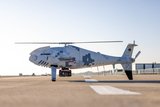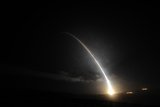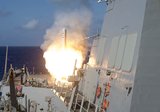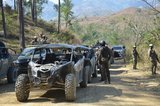Beijing's South China Sea bombers fly in face of protests
China's brazen landing of nuclear-capable bombers on anisland in the disputed South China Sea is a bold power play to bolster its territorial claims while rivals are divided and the US distracted by North Korea, analysts say.
China attracted diplomatic protests after long-range H-6K bombers carried out landing and takeoff drills at an unidentified island airstrip on 18 May.
But Beijing has long brushed aside such condemnation, denying that it was militarising the region even though it has installed an array of airstrips, radar systems and naval facilities on a string of islands it has reclaimed in contested areas since 2013.
The planes are believed to have landed on Woody Island, China's largest base in the Paracel Islands which is also claimed by Vietnam and Taiwan, according to Bonnie Glaser, a China expert at the Centre for Strategic and International Studies (CSIS) in Washington.
An H-6K long-range strategic bomber deployed to Woody Island could reach almost the entire South China Sea and many countries surrounding it, according to a CSIS analysis.
The steady buildup of military assets in the waterway – believed to have significant oil and natural gas deposits – allows China to ‘influence its weaker neighbours in peacetime,’ Glaser said.
Glaser added: ‘Through the use of a large number of law enforcement ships, for example, it can pressure Vietnam and the Philippines not to unilaterally extract energy in waters that China claims jurisdictional rights.
‘In wartime, China's military assets on these islands will increase the risk to the US of intervening militarily.’
Earlier in May 2018 China deployed anti-ship cruise missiles and surface-to-air missiles on the disputed Spratly Islands off the Philippine coast, CNBC reported, citing sources close to US intelligence.
Beijing claims virtually all the South China Sea and has ignored partial counter-claims from the Philippines, Vietnam, Taiwan, Brunei and Malaysia.
The Pentagon condemned bomber drills on 18 May as a sign of ‘continued militarisation’ of disputed islands while Vietnam said the move violated its sovereignty and raised tensions in the region.
The Philippines, which has largely backed off from the sea dispute under China-friendly President Rodrigo Duterte, said it was taking ‘appropriate diplomatic action.’
Despite the rhetoric, experts say little has been done to prevent China from solidifying its vast maritime claims.
Beijing has managed to weaken regional resistance by courting some members of the 10-nation Association of Southeast Asian Nations.
While US warships have conducted ‘freedom of navigation’ operations near Chinese-claimed features, they have not deterred Beijing.
The bombers were deployed while US President Donald Trump is focused on preparing for a summit with North Korean leader Kim Jong Un in June 2018.
Euan Graham, director of the international security programme at the Australian think tank the Lowy Institute, said: ‘I think there is an obvious political motivation for the timing. Because the US is mainly engaged in the North Korea files... there is a window of opportunity where the US reaction is likely to be restrained.’
China's foreign ministry has repeated denials that the region was being militarised, saying the islands belong to Beijing and the bombers were conducting ‘normal training’.
The latest exercises were ‘largely symbolic’ and not a significant military development, Graham said.
To deploy from Woody Island, China would have to install logistics infrastructure to operate aircraft, refuel them, store weapons and house crews, he said.
Graham said: ‘Just landing an aircraft doesn't make it an operational space.’
It would be more significant if and when China starts flying combat aircraft to the Spratlys, he said, because that would bring northern Australia into missile range.
Nearly a third of global trade passes through the South China Sea and Beijing has bigger commercial and military ambitions for this strategic sea area, said William Choong, a senior fellow at the International Institute for Strategic Studies in Singapore.
China could create an air defence identification zone to spot incursions into its claimed sovereign airspace, something it did in the East China Sea in 2013 amid a dispute over the Senkaku islands with Japan, Choong said.
Beijing could also establish a base for nuclear submarines as the deep waters around the Spratlys ‘provide a good hiding place,’ he said.
Despite the looming threat, the international community – including India, Japan, the US and Australia –has failed to achieve a united front against China's island-building spree, Choong said.
Choong added: ‘Apart from the freedom of navigation missions and the strong rhetoric, the US hasn't been able to corral together a coalition of the willing, to effectively to get China to stop the militarisation of the South China Sea.’
More from Defence Notes
-
![US lawmakers warn that “more military spending is absolutely necessary” to ensure Pentagon’s readiness]()
US lawmakers warn that “more military spending is absolutely necessary” to ensure Pentagon’s readiness
The US Congress has raised concerns about how inflation rates and cuts in main acquisition programmes could affect the US military.
-
![Can the US overcome Russian and Chinese nuclear capabilities?]()
Can the US overcome Russian and Chinese nuclear capabilities?
Washington’s ageing inventory and the pace Moscow and Beijing have been modernising their capabilities put in check the US Nuclear deterrence.
-
![US FY2024 funding package passes as China closes military capability gap]()
US FY2024 funding package passes as China closes military capability gap
The Pentagon has been operating under temporary funding since October 2023, which has impacted its main acquisition and development programmes, increasing the capability gap between the US and China.
-
![NATO outlines future challenges as Ukrainian funding from US stalls]()
NATO outlines future challenges as Ukrainian funding from US stalls
In 2023, defence spending increased by an unprecedented 11% across European NATO countries and Canada. Since 2014, the group has spent an additional US$600 billion on defence.
-
![US Pentagon to reduce investments in main acquisition programmes over FY2025]()
US Pentagon to reduce investments in main acquisition programmes over FY2025
The DoD requested nearly US$850 billion to fund operations over the next fiscal year. Despite the amount being 1% higher than the FY2024 budget request, it has not covered the 3% inflation rate, which could impact the DoD’s main programmes in the medium and long term.
-
![Haiti crisis forces Caribbean militaries to prepare for intervention]()
Haiti crisis forces Caribbean militaries to prepare for intervention
As gangs gain control of Port-au-Prince, Haiti’s Caribbean neighbours have been preparing to intervene in the failed state, with the US and other partners waiting in the wings with equipment and financial support.

























